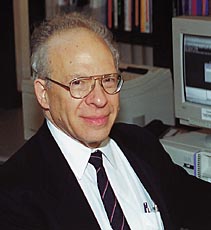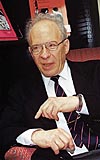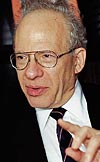| Chemical and Engineering News
GOVERNMENT & POLICY Volume 78, Number 19 CENEAR 78 19 pp. ISSN 0009-2347 |
|||||||||||||||||||||||||||
|
Nuclear weapons guru Richard Garwin mulls post-Cold War era of heightened concerns about nuclear arms proliferation Richard L. Garwin knows nuclear weapons. He has known them for 50 years. It is not an exaggeration to say he understands the complex interactions among the scientific, operational, and policy aspects of nuclear weaponry as well as anyone in the country, if not better. His knowledge dates back to the early 1950s. Then, as a newly graduated doctoral physicist from the University of Chicago, he was helping turn the fundamental concepts of mathematician Stanislaw Ulam and physicist Edward Teller for a thermonuclear explosion into an arsenal of incredibly destructive weapons. Although Garwin's primary day job has been inventing things for IBM, he has served under every Administration since Eisenhower's on innumerable panels, giving advice and counsel to the defense establishment and other government agencies, including the White House, on scientific and technological matters. For decades, he has been a member of JASON, a group of distinguished nongovernment scientists that gathers in retreat periodically to tackle highly technical national security problems brought to it by the Departments of Defense and of Energy. Among other duties, he is currently chairman of the Arms Control & Nonproliferation Advisory Board to the Secretary of State. In 1996, he received from the U.S. intelligence community the prestigious R. V. Jones Award for Scientific Intelligence. Also in 1996, President Clinton and the Department of Energy presented him with the Enrico Fermi Award for his work on nuclear weapons.
But with all his experience, technical expertise, and intellectual prowess, Garwin's analyses of the hardware of nuclear war always boil down to answering a few practical, very commonsense questions. Will it work? Will it do anything useful? Will it enhance U.S. national security? Can it readily be countered? Will it increase or decrease global nuclear stability? Despite ratification by the Russian parliament of two arms control agreements last month, three of the closely interlocking pillars of the laboriously developed arms control approach to lessening the likelihood of any further use of nuclear weapons in war remain under duress. First, the Comprehensive Test Ban Treaty (CTBT) , which prohibits all nuclear explosions of any size, by any party, anywhere, was soundly rejected by the Senate last October. Second, a new push to have the U.S. commit itself to building a nationwide ballistic missile defense system as soon as technically feasible threatens to undermine the 1972 Antiballistic Missile (ABM) Treaty that prohibits such systems. Third, the testing of nuclear weapons by India and Pakistan in 1998 shows the fragility of the Nuclear Nonproliferation Treaty (NPT) that had already been undermined by Israel's nuclear weapons. This agreement limits possession of nuclear weapons, supposedly for all time, to the five states that had them in 1968: the U.S., the Soviet Union, the U.K., France, and China. Neither Israel, India, nor Pakistan has signed the NPT. In recent public statements and testimony, Garwin has spoken out in strong opposition to a ballistic missile defense system now being proposed to protect the territory of the U.S. against an attack by a few intercontinental ballistic missiles (ICBMs) carrying biological or nuclear weapons fired by a rogue nation, such as North Korea. The scheme would involve a base, probably in Alaska, for a hundred or so hit-to-kill interceptors. He sees such an attack as very unlikely because of the U.S.'s nuclear deterrence capability as well as its ability to deliver nonnuclear preemptive strikes. He also believes that if a nation still decided on a nuclear attack on the U.S., it would not use ICBMs launched from its own territory. It would more likely employ a simpler, more reliable delivery system that may also obscure the source of the attack--such as in the hold of a freighter. Garwin also claims that the proposed defensive system--which is designed to intercept warheads in midcourse above the atmosphere--would have zero effectiveness against ICBMs carrying either biological or nuclear warheads. The decision point that seems to be approaching is, will the world continue, however haltingly, down the arms control road of ever-declining nuclear arsenals leading potentially to their elimination, as called for in the preamble to the NPT, or will the path be to a de facto situation in which any nation that wants nuclear weapons and can afford them will have them--with the U.S. having the largest and most sophisticated stockpile? Either way, for the science community, keeping the 20th-century technology of nuclear weapons from destroying mankind will be one of the greatest challenges of the 21st century. C&EN first spoke with Garwin at length in 1981 at the height of the Cold War. At that time, then-Editor Michael Heylin sought his views about the buildup in nuclear weaponry under way by both the U.S. and the Soviet Union (C&EN, Sept. 28, 1981, page 26). Over the years, Garwin has been interviewed numerous times, and last month, Garwin and Heylin got together again. This time, the topic was the increasingly uncertain worldwide outlook for nuclear weapons and their control in what was supposed to be a more benign post-Cold War era. C&EN: One of the arguments that was influential in the Senate's rejection of the CTBT was that the reliability and safety of U.S. nuclear warheads cannot be ensured without nuclear testing. But such tests are done under artificial conditions largely unrelated to the operation of weapons systems. Also, we could not do enough of such tests to obtain statistically significant reliability data, anyway. So does nuclear testing have a role in ensuring reliability? Garwin: We can maintain our warheads to be as reliable as they ever were, indefinitely, without nuclear testing. JASON did a study of this and found that nuclear testing has told us essentially nothing about the reliability of the warheads that are in the U.S.'s arsenal today.
C&EN: The only reliability that really counts is that of entire weapons systems, not just of their warheads, which represent just one stage in their operation. Correct? Garwin: It has always been the case that weapons system reliability is what counts. We have had some precision flight tests of weapons systems that involve all the stages but the final nuclear explosion. These are important, but we have so few of them that we don't know the reliability of the various stages. If you want to increase the reliability of a nuclear weapons system, don't concentrate on the nuclear explosive because it is the most robust step in the sequence. C&EN: Another argument against CTBT during the Senate debate was that there could be some sudden scientific breakthrough that could change the nuclear balance. Is this so? Garwin: People talk about so-called third-generation, nuclear-powered, directed-energy weapons--various particle beams, X-ray lasers, and the like. I have analyzed many of these schemes. And you can't say that, with enough billions of dollars and continued nuclear testing, something like that couldn't be developed. But there are fundamental limits on what you could do with such things--such as uncertainty about propagation through the atmosphere and the availability of simple countermeasures. If anything like this were ever developed, the question would then be, is it something the U.S. could benefit from? Maybe. But is it worth allowing all kinds of other people to test real nuclear weapons that can destroy cities to gain an extra weapon that somebody imagines could do certain specific things sometime in the future? No! Also, other people's breakthroughs don't require advances by us. India and Pakistan tested, but we don't have to go back to testing because there is nothing new for us to do. C&EN: What about the argument that, just on first principles, as long as the U.S. considers nuclear weapons as vital to its security, it must retain the right to test them? Garwin: There is a view that the U.S. is a singular country that shouldn't have any limitations put on what it can do. That's the equivalent of saying, "I am such a special individual, I don't have to obey any laws. Since I am not a criminal, let's get rid of the laws." That makes no sense to me. You have to ask what the U.S.--which has already had more than 1,000 nuclear tests--can gain from further tests and compare that with what a potential proliferator with no nuclear tests until now can gain by testing. U.S. national security is much better served by keeping other nations from testing. I believe that the CTBT's major benefit to the U.S.--keeping other people from testing--really did not come up in the so-called Senate ratification debate. Of course, with no limits on testing, we could continue to refine weapons and we could develop and deploy new earth-penetrating or other optimized weapons for particular tasks. But doing these things would not compare with the benefits to the U.S. from having nobody test. C&EN: Nuclear warheads cannot last forever. So what about the argument that remanufacturing nuclear warheads 50 or more years after they were originally made, something we may have to do, could introduce enough uncertainties to necessitate nuclear testing of the new ones to make sure they work? Garwin: It depends on how hard you try to maintain the design and processes you had before. The key is to be prudent and avoid the temptation to improve the designs and processes. If we are prudent, I absolutely believe we can maintain a reliable nuclear arsenal without nuclear testing. The guideline should be, If it isn't broken, don't fix it. And if it does break or age, rebuild it. C&EN: How do you assess the $4.5 billion-per-year science-based stewardship program the Department of Energy has set up to keep the current U.S. nuclear arsenal reliable and safe without nuclear testing? Garwin: The program has two goals. One is to keep weapons safe and reliable without nuclear testing. The other is to maintain the scientific and technical capabilities of the nuclear weapons community by retaining and attracting good people so that nuclear testing and weapons design can resume promptly if the CTBT era collapses. The weapons lab directors argue that both of these goals require the best scientific tools. One of the arguments for new scientific tools is that an aged nuclear weapon is a more complicated thing than a newly manufactured weapon. New ones don't have any defects. But geriatric ones are more complicated because things can go wrong. You have to worry about the equivalent of arthritis and the like. The answer to the reliability issue is enhanced stockpile surveillance and nonnuclear testing of the large majority of nuclear weapons components, combined with remanufacture when necessary. But the labs have not yet addressed the issue of remanufacture. Much of the stewardship focus is on the new scientific tools--the National Ignition Facility (NIF) now under construction at Lawrence Livermore National Laboratory , the Dual-Axis Radiographic Hydrodynamic Test Facility at Los Alamos National Laboratory , and a three- to six-orders-of-magnitude boost in the computer capability of the weapons program. These will be nice things to have scientifically when they eventually come onstream. But they are more related to attracting skilled staff than to maintaining weapons reliability and safety. NIF is oriented toward ignition of tiny amounts of thermonuclear fuel--an achievement that has been wrongly characterized by a leader of the weapons program as essential to the credibility of the stockpile stewardship program. These will be nice things to have scientifically when they eventually come onstream. But they are more related to attracting skilled staff than to maintaining weapons reliability and safety. NIF is oriented toward ignition of tiny amounts of thermonuclear fuelMan achievement that has been wrongly characterized by a leader of the weapons program as essential to the credibility of the stockpile stewardship program.
I say that under a CTBT era, you maintain the capability to test, but that does not mean you are going to test. The same for design: You retain the capability, but you don't do it, as a matter of prudence. What about the charge that other nations will cheat on the CTBT and develop useful new weapons with clandestine testing programs that cannot be detected? This claim has been promoted by a number of leaked stories that are not well founded scientifically. Garwin: The International Monitoring System (IMS) being installed under CTBT has great capability. It enables the deployment of seismometers in countries that have signed the treaty where we could not have them before. IMS can detect a 1-kiloton nuclear explosion anywhere in the world with confidence. The detection level is much better in many areas. For instance, a seismometer array in Norway can detect explosions at the old Soviet testing site on the island of Novaya Zemlya off the Arctic Coast of Russia down to less than a ton. The U.S. will continue to monitor for clandestine nuclear tests with its own detection systems, with or without CTBT. With CTBT, we would also get a bigger and better system and for only 25 cents on the dollarMthe U.S. pays 25% of IMS costs. C&EN: What about the argument that has been around since the early 1960s that so-called decoupled tests--in which nuclear devices are exploded in underground cavitiesMcannot be detected because the seismic signals they produce are greatly reduced? Garwin: This is a red herring. There have been only one or two such tests on each side. They need a really enormous underground cavern for any but very small tests--down around a kiloton. Mining out such caverns would be very difficult. And there aren't natural caverns at suitable locations and depths for testing of any military significance. Also, natural caverns would very likely leak telltale radioactive debris from a nuclear test. C&EN: On what grounds do you claim that missile defense being proposed would be such a total bust? Garwin: In the biological weapon case, the biological agent would be dispersed in a cloud of bomblets from the ICBM just as it reached its maximum velocity at the end of the boost phase. These would reenter the atmosphere separately and land over a wide target area. Because of their sheer numbers alone, they would be impossible to intercept. Also, any nation capable of producing and launching a nuclear-armed ICBM, however crude, at the U.S. would certainly have the ability to add relatively low-tech decoys of various sorts to evade the missile defense now being proposed. If, for whatever reason, you really want missile defense, the way to do it is to attack the missiles during their boost phase. Then, the target is large, the ICBM itself. It is easy to track because of the flare coming out of the back of it. Also, there can be no practical decoys. Such a defensive system would have to be based within a few hundred miles of the ICBM launch site either on land or on ships. C&EN:What impact do you believe deployment of a missile defense system by the U.S. would have on the arms balance? Garwin: For one thing, the proposed system is scoped to deal with China's force of about 20 missiles capable of striking the U.S. What will happen? China will use decoys on its old missiles and deploy a new mobile missile. That would give us the worst of two worlds: We will have bad political relations, and we will have handed China an argument for building up its ICBM force. C&EN: A hypothetical question: How could a potential enemy ever learn that the U.S.'s deterrent force had become so unreliable that it could risk a strike on the U.S. and probably get away with it? Garwin: They would probably read about it in a story leaked to the Washington Times. This is an argument used against CTBT: that the U.S. would never admit that it needed to start testing again because it had lost faith in its nuclear weapons and so would let them slowly rot. But that is not the game. Under CTBT, we can and will maintain our weapons. Otherwise, the weapons labs and the military would never have signed off on CTBT in the first place. Also, the weapons labs have to certify each year that the U.S. nuclear arsenal remains in good shape; most recently, it did so in April. I don't think the leaders of this country really know what the nuclear weapons complex is doing. By slighting remanufacturing, it is not doing the things that can and should be done to retain weapons reliability. So one day it will demand to test again--thus seeking a reward for its own poor performance, at the cost of U.S. and world security. C&EN: What is your prognosis for nuclear weapons and their control for the next few years? Garwin: It is a critical time for choosing the path forward for the 21st century. Will there be nuclear weapons for everybody and greater uncertainty about their use? Will there be declining arsenals and a diminished threat? Will the U.S. --as the last superpower--so prize its current force of about 10,000 nuclear weapons either deployed or in reserve that it will imperil its interest in limiting the nuclear arsenals of other powers? I believe that a total of 2,000 U.S. weapons is the maximum compatible with our efforts to limit the nuclear threat. And this level needs to be seen, through security guarantees about how the weapons will and won't be used, as serving the security interests of the vast majority of nations that have forsworn nuclear weapons.
Chemical & Engineering News |
|||||||||||||||||||||||||||
|
Copyright © 2000 American Chemical Society - All Right Reserved 1155 16th Street NW • Washington DC 20036 • (202) 872-4600 • (800) 227-5558 |




